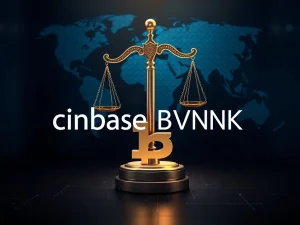Essential SEC Guidance: Navigating Crypto Securities Laws for Digital Asset Compliance

In a move that has sent ripples through the crypto industry, the Securities and Exchange Commission (SEC) staff has offered much-anticipated guidance on how federal securities laws crypto could apply to the burgeoning world of digital assets. This nonbinding guidance, issued by the SEC’s Division of Corporation Finance, aims to provide clarity for crypto companies and industry players on disclosure practices, a crucial step as the regulatory landscape for cryptocurrencies continues to evolve. Are you ready to understand how this impacts you?
Decoding the SEC’s Stance on Crypto Regulation
The SEC staff statement, released on April 10th, explicitly states its intention to offer “greater clarity on the application of the federal securities laws crypto assets.” This guidance is born from observations of existing disclosures and directly addresses questions raised by market participants. While emphasizing that this is not legally binding, the SEC’s Division of Corporation Finance is signaling a proactive approach to regulating the crypto space, urging companies to be more transparent and detailed in their disclosures.
Key Disclosure Areas Highlighted by SEC Guidance
What exactly does the SEC want crypto firms to disclose? The guidance spotlights several critical areas, urging companies to provide comprehensive details about:
- Business Operations: A clear description of what the company does, how its tokens function, and how revenue is generated or planned.
- Token Functionality: Detailed explanations of how issued tokens operate within their ecosystem.
- Post-Launch Engagement: Plans for continued involvement in the crypto network or application after launch, and if not, who will take over.
- Technology Stack: In-depth information about the underlying technology, including consensus mechanisms (proof-of-work or proof-of-stake), block size, transaction speeds, reward systems, security measures, and whether the protocol is open-source.
This level of detail underscores the SEC’s push for transparency, ensuring investors have a clearer picture of the projects they are engaging with.
Navigating the Nuances of Digital Asset Compliance
A key takeaway from the SEC’s statement is that registration or qualification isn’t necessary for crypto offerings that are not securities laws crypto and aren’t part of an investment contract. However, the million-dollar question remains unanswered: what exactly constitutes a security in the digital asset realm? The statement doesn’t provide a definitive list, leaving room for interpretation and potentially further discussion.
Joe Carlasare, a commercial litigator, views this guidance as “a welcome and refreshing step toward clearer crypto regulation.” He emphasizes that adhering to these guidelines will not only improve a company’s standing with regulators but also demonstrate a commitment to transparency and build credibility within the industry.
Risk Disclosure: A Cornerstone of SEC Expectations
The SEC staff stresses the importance of thorough risk disclosure. Beyond standard business and legal risks, companies are expected to clearly outline risks specific to the crypto world, including:
- Price Volatility
- Network and Cybersecurity Vulnerabilities
- Custody Risks
Furthermore, issuers must provide a “materially complete description” of a security, encompassing details about dividends, distributions, profit-sharing, and voting rights, including the mechanisms for enforcing these rights. Transparency extends to the protocol’s code – disclosures should cover whether the code can be modified, who can make changes, and if smart contracts have undergone third-party security audits.
Beyond the Basics: Deeper Dive into Token Disclosure
The SEC’s guidance delves deeper into token specifics, requiring disclosures on:
- Token Supply: Whether the token supply is fixed and how it was or will be issued.
- Key Personnel: Identification of executives and “significant employees.”
These requirements reflect a comprehensive approach to digital asset compliance, moving beyond surface-level information to core operational and structural details.
The Bigger Picture: SEC’s Crypto Task Force and Future Roundtables
This guidance is not an isolated event. It’s part of a broader strategy spearheaded by the SEC’s Crypto Task Force, which plans to conduct a series of roundtables with the crypto industry. These discussions will focus on critical areas such as policing crypto trading, custody, tokenization, and decentralized finance (DeFi). This initiative signals the SEC’s commitment to ongoing dialogue and collaboration with the crypto industry as it refines its regulatory approach.
Conclusion: Embracing Transparency in the Crypto Era
The SEC’s recent guidance serves as a crucial roadmap for crypto companies navigating the complexities of crypto regulation and token disclosure. While questions remain, particularly around the definition of a “security” in the crypto context, this step towards clarity is undoubtedly a positive development. By emphasizing transparency and comprehensive disclosure, the SEC is encouraging a more mature and responsible crypto market. For crypto businesses, embracing these guidelines is not just about compliance; it’s about building trust, fostering investor confidence, and paving the way for the sustainable growth of the digital asset ecosystem. The message is clear: transparency is no longer optional – it’s essential for navigating the future of crypto.







